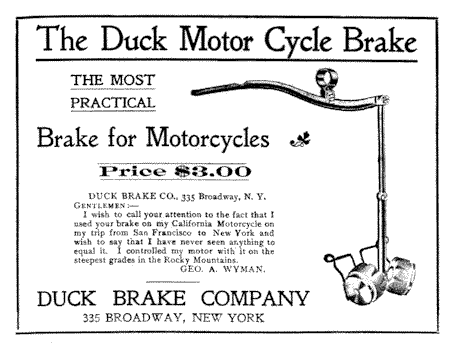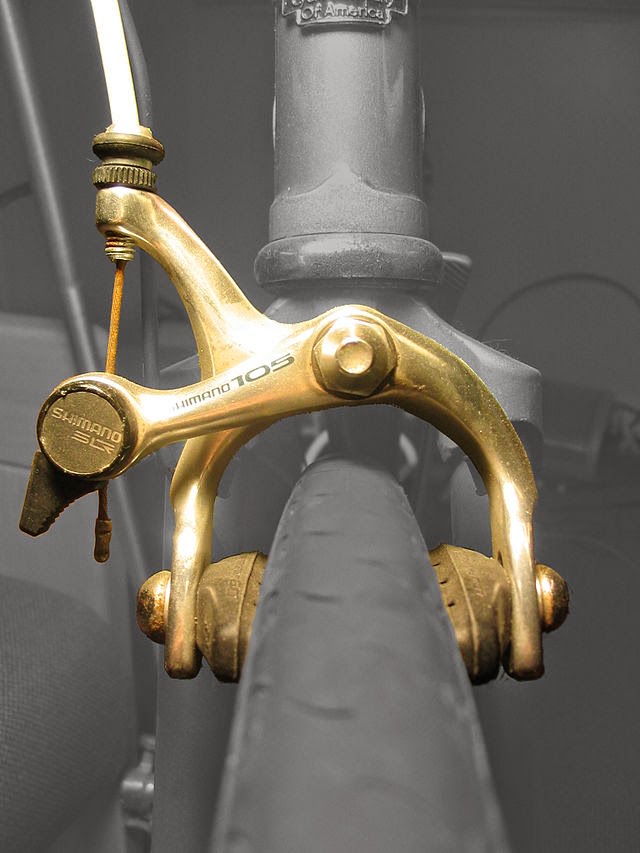I'll give you a list of products that you might need first. You will have to read through the tutorials before buying the parts, as you are probably not aware of what is needed and what isn't. Throughout the article I will use the abbreviation [opt.]. It means that it is not a necessity, but it might save you time and nerves if you use it. It won't ensure better quality though. The quality solely depends on your handiness and you using your brain.
A list of spare parts for your bicycle that you might or will need throughout this guide
Replacing your brakes and replacing a brake shoe (brake pad or brake block)
Before I start explaining, you will have to be aware that there are different kinds of brakes. What kind of brake you have is important to know how to replace it. Some of the brakes I will refer to are obsolete. I only mention them so you can understand the many changes the bicycle brake went through.Spoon brake (or plunger brake)
If you have a spoon brake, you must have an antique bicycle. A spoon brake metal plate is directly pressed upon the tire of the wheel. The plate is attached to a rod that is mostly positioned at the right side of the handle bars. I doubt the fact that you will have to replace this part as it is not manufactured anymore.Duck brake (Duck roller brake)
This brake made the spoon brake obsolete and was invented around the end of the 19th century. It was operated by a rod connected to a lever on the handle bar. You can brake by pulling the lever, so that 2 friction rollers are forced against the front wheel.Source: earlymotor.com/leon/bikes/california/images/duck.gif
Coaster brakes, Back Pedal Brakes, Foot Brakes, Torpedo or Contropedale
By reading the title, you know which brake comes next. I like this brake a lot and associate it with a classic Dutch 'granny bike'. A granny bike (oma fiets) is a very typical bicycle with very typical features. It's always a ladies' bike, has a classical touch (design, slight rust, colour, etc.) and has no gears or three gears. Oh, and it has a back pedal brake. Just enter 'oma fiets' in Google and you will see what bike I am talking about.A coaster brake is located in the back hub of the wheel. It is operated by pedaling backwards, which makes the sprocket drive a screw which forces a clutch in the opposite direction of the axle. This will either force two brakeshoes against the brake mantle or into a split collar expanding it against the mantle.
Rim brakes: many variations of the same kind of brake
There are so many kinds of rim brakes. Even though the basic principle is the same, they differ on many levels.
It will take a while to make repair guides for all these sub categories of rim brakes. As there are so many kinds of rim brakes, I will spread the tutorials over a few articles, making sure that I will cover all variations of rim brake in one article.Rod brake
A rod brake, also called a rod-actuated brake or stirrup brake (due to their shape), is used by pulling a rod that is placed under the whole handlebar. The rod is connected to a brake with brake shoes. The brake shoe presses on the rim, to stop the wheel from rotating. These brakes are still in use in the third world.Caliper brake design
Single-pivot side-pull caliper brakes
The Caliper brake design is a type of brake in which the brake mounts to a point above the wheel, allowing the arms to auto-centre on the rim. The single-pivot side-pull caliper brakes consist of two arms that cross at the pivot and hold the brake shoes on the opposite side of the rim. When the lever is pulled, the arms will contract, making the brake shoes press upon the rim. This brake is used on older racing bikes. I have an old bicycle (not here now though), so I'll have a look at my brake.Source: upload.wikimedia.org/wikipedia/commons/thumb/8/80/Bicycle_caliper_brake_highlighted.jpg/170px-Bicycle_caliper_brake_highlighted.jpg
Caliper brake design: Dual-pivot side-pull caliper brakes
Most modern race bikes have a dual-pivot side-pull caliper brake. The cable housing attaches like that of a side-pull brake. One arm pivots at the center; the other one pivots at the side, much like a center-pull.Caliper brake design: Centre-pull caliper brakes
I have had this brake on 80 % of my bikes. This is like the most typical brake. A small lever on the left and right side of the handle bar is attached to the front and rear tire of the bike. The brake consists of the arms, symmetrically opposed to eachother and connected in the middle with a screw. On the end of these arms are brake pads, which positioned opposed to the rim. These brake arms are connected to the lever by iron cables and - before the cable reaches the arms - these cables get split using a 'sliding piece' (also called "braking delta", "braking triangle" or "yoke"). The tension will be evenly divided between both braking pads, making these braking pads ideal to true your wheel ( see: Trueing your wheel: buying-spare-parts-wheel-part-2.html ).U-brakes (990 style brakes)
Commonly used on BMX and considered as the default brake. The caliper design with pivots is right above the rim. The arm pivots attach directly to the frame as opposed to the centre-pull brakes. In its maintenance, it is quite similar to roller cam brakes.Cantilever brake design
All cantilever brakes are dual pivot brakes, where each arm is attached separately on one side of the fork. This brake is mainly used for wide tires, commonly used on city bikes and mountain bikes.Traditional cantilever brakes
The traditional cantilever brake even predates the direct-pull brake. It consists of 2 outwardly angled arms on each side, a cable stop on the fork to terminate the cable housing, and a cable connecting the arms like a centre-pull caliper brake.V-brakes
The V-brake is a trademark of Shimano and is also called linear-pull brake. With no intervening mechanism between the cable and arms, it is also called a direct-pull brake. A cable moves from the lever on the handlebar towards the cable housing. Before it reaches the cable housing, it will move through a 'noodle'. This is a metal tube that moves 90° to the cable housing, which is placed horizontally above the tire. The end of the cable is attached to the arm opposed to the side of where the cable came from (normally on the right side). If the cable would only be attached to this arm, then it would be the only working brake pad, as there is no pressure on the other brake arm. Here the noodle comes in to play. The noodle is clamped in the cable housing and pulls the other brake arm simultaneously. I'd say that it is the most important part of the brake and should be qualitative. You wouldn't want it to bend when you need it most.Mini-V-brakes are also a kind of V-brake but smaller. Not going to write to much about this one.
There are more kinds of brakes but I am not going to spend time on it right away.
- Roller cam brakes
- Delta brakes
- Hydraulic rim brakes
- Rim brakes with self-assisting characteristics
We will get into that too. First I'll have to work on the repair guide. You'll read about that in part II.


No comments:
Post a Comment